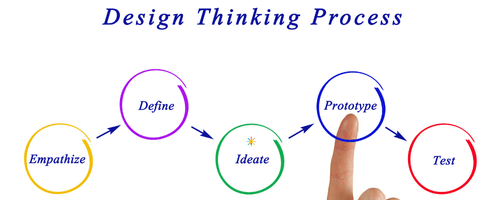The thought process is the way our mind forms, organizes, and connects ideas to make decisions, solve problems, or understand the world. It involves reasoning, analyzing, recalling past experiences, and imagining future possibilities.
The thought process is the way our mind works to make sense of the world. It’s like an inner conversation where we gather ideas, analyze situations, solve problems, and make decisions. It’s how we connect the dots between what we know, what we feel, and what we experience. Sometimes it’s quick and automatic, like when we react to something instantly, and other times it’s slow and deliberate, like when we deeply think through a tough decision. Essentially, it’s the mental journey that shapes our actions, beliefs, and how we navigate life.
Have you ever stopped to think about how much your thoughts influence your life? I mean, think about it. It’s easy to go through the day on autopilot, letting our minds wander wherever they please. But what if I told you that the thoughts swirling around in your head have the power to shape not just your mood, but the entire environment around you? It’s true. Our thoughts are like invisible architects, quietly designing the world we live in. And when we start to take control of them, something magical happens—we begin to create a more positive, peaceful, and uplifting space for ourselves and everyone around us.
Let’s dive into this idea and explore how our thought process holds the key to transforming our environment.
What is a Thought Process?
At its core, a thought process is how we make sense of the world. It’s the constant stream of ideas, beliefs, memories, and reactions that flow through our minds from the moment we wake up to the moment we fall asleep. Think of it like a mental playlist—sometimes it’s upbeat and inspiring, other times it’s a little too heavy on the sad songs.
The beauty of our thought process is that it’s not fixed. Sure, our thoughts are influenced by our experiences, emotions, and surroundings, but here’s the kicker: we have the power to influence them too. When we learn to guide our thoughts intentionally, we’re not just improving our own mental landscape—we’re changing the energy we bring into every room we enter.
Thought Process Matters for Creating a Positive Environment

Creating Mental Space for Positivity
Imagine your mind is a garden. If you let negativity take over, it’s like allowing weeds to grow unchecked. But when you consciously plant seeds of gratitude, hope, and kindness, you create a space where positivity can thrive.
I’ll give you an example. A few months ago, I was having a rough week. Everything felt like it was going wrong, and my mind was stuck in a loop of frustration. Then, I decided to try something simple: every night before bed, I wrote down three things I was grateful for. At first, it didn’t come naturally, but gradually, I began to see a change. My mind started to naturally focus on the good things, even on tough days. That small act of intentional thinking didn’t just change my mood—it changed the way I interacted with the people around me. Positivity, it turns out, is contagious.
Turning Challenges Into Opportunities
Life is full of challenges, big and small. But here’s the thing: it’s not the challenge itself that defines us—it’s how we think about it. When we approach obstacles with a growth mindset, we start to see them as opportunities rather than setbacks.
Take a difficult conversation, for instance. It’s easy to go into it feeling defensive or anxious. But what if, instead, you thought of it as a chance to learn something new or strengthen a relationship? That shift in perspective can completely change the outcome. By reframing challenges, we create an environment that fosters creativity, resilience, and collaboration.
Influencing Others Through Our Thought Process
Our thoughts don’t just affect us—they ripple out into the world. Have you ever been in a room where someone walks in with a big smile and a positive attitude? It’s like the whole atmosphere brightens. That’s the incredible influence of thought at work.
When we choose to think positively, we send out an energy that encourages others to do the same. It’s not about pretending everything is perfect; it’s about choosing to focus on what’s good and possible. And when we do that, we create a space where people feel inspired, supported, and uplifted.
The Ripple Effect of Mindful Thinking
Mindfulness is one of the most powerful tools we have for shaping our thought process. When we practice mindfulness, we’re fully present in the moment, paying attention to our thoughts and feelings without judgment. This simple act can have a profound impact on how we interact with our environment.
For example, let’s say you’re in a stressful meeting at work. Instead of letting your mind spiral into worry or frustration, you take a deep breath and focus on what’s happening right now. That moment of mindfulness allows you to respond thoughtfully rather than react impulsively. The result? A calmer, more productive environment for everyone.
Building Emotional Resilience
Emotional resilience is like a mental muscle—it gets stronger the more we use it. And one of the best ways to build it is by consciously choosing how we think about setbacks and failures.
Instead of dwelling on what went wrong, try focusing on what you can learn from the experience. Maybe a project didn’t go as planned, but it taught you a valuable lesson about teamwork or time management. When we approach life with this mindset, we not only bounce back faster but also set an example for others. In a community or workplace, emotional resilience can transform the environment into one that’s more understanding, adaptable, and supportive.
Designing Your Thought Process

Let’s talk about something we often take for granted: our thought process. It’s the invisible framework that shapes how we see the world, how we react to it, and ultimately, how we live our lives. Think of it like designing a room—you get to decide what goes in it, what stays, and what gets tossed out. The same goes for your mind. By intentionally shaping your thoughts, you can create a mental space that’s positive, productive, and empowering—not just for yourself, but for everyone around you.
Designing your thought process isn’t about flipping a switch and suddenly thinking happy thoughts all the time. It’s about being intentional. It’s about building habits, beliefs, and attitudes that align with who you want to be and how you want to show up in the world. Here’s how you can start designing a thought process that works for you.
1. Become Aware of Your Thoughts
The first step is simple but powerful: pay attention. Pause for a second and tune in to what’s happening in your mind. yourself—it’s about understanding your mental patterns.
For example, I used to catch myself spiralling into worry over things that hadn’t even happened yet. Once I started noticing this pattern, I could catch myself mid-spiral and say, “Hey, let’s not go down that road.” Awareness gives you the power to redirect your thoughts before they take over.
2. Challenge Negative Beliefs
We all have those sneaky beliefs that hold us back—thoughts like “I’m not good enough” or “I’ll never get this right.” The problem is, we often accept these beliefs as facts without questioning them.
Here’s a game-changer: start asking yourself, “Is this really true?” or “What proof do I actually have for this?” In many cases, you’ll discover that these beliefs are based on fear rather than reality. Once you challenge them, you can replace them with thoughts that empower you, like “I’m capable of figuring this out” or “I’m learning and growing every day.”
3. Focus on Solutions and Opportunities
Life is full of obstacles, but here’s the thing: where you focus your energy matters. Instead of getting stuck on what’s going wrong, ask yourself, “What can I do about this?” or “What’s the opportunity here?”
I remember a time when I was overwhelmed at work. Everything felt like a problem. Then I decided to shift my focus. Rather than getting stuck in the stress, I began asking myself, “What’s one tiny thing I can do at this moment?” That simple shift in thinking helped me move forward instead of feeling stuck.
4. Practice Gratitude and Visualization
Gratitude is like a magnet for positivity. When you take time to appreciate what’s good in your life, you train your brain to notice more of it. Try this: every night, write down three things you’re grateful for. They don’t have to be big—maybe it’s a good cup of coffee, a kind word from a friend, or even just the fact that you made it through the day.
Now, pair gratitude with visualization. Picture yourself achieving your goals or handling a tough situation with confidence. This isn’t just daydreaming—it’s a way of programming your mind for success.
5. Cultivate Mindfulness and Emotional Control
Mindfulness means fully experiencing the here and now, without letting judgment cloud your perspective. It’s like hitting the pause button on life so you can respond thoughtfully instead of reacting impulsively.
For example, when you’re in a heated conversation, take a deep breath before responding. That moment of mindfulness can help you stay calm and focused, even when emotions are running high. Over time, this practice helps you navigate life’s ups and downs with clarity and grace.
Why This Matters
Designing your thought process isn’t just about feeling better—it’s about creating a life that reflects your values and goals. When you steer your thoughts, you’re also directing your energy. And that energy doesn’t just affect you—it ripples out into the world.
Imagine walking into a room with a calm, positive mindset. People notice. They feel it. Your energy can inspire others, create deeper connections, and even transform the atmosphere of a space.
So, what kind of thought process will you design for yourself? One that’s cluttered with negativity and self-doubt, or one that’s filled with gratitude, resilience, and possibility? The choice is yours, and the impact is limitless.
Start small. Notice your thoughts. Challenge the ones that don’t serve you. Focus on what’s good and what’s possible. And remember, you’re not just designing your thoughts—you’re designing your life.
How to Nurture a Positive Thought Process

Nurturing a positive thought process is a practice, not a one-time fix. Here are a few easy yet impactful ways to begin:
- Reframe Negative Situations: When something goes wrong, ask yourself, “What can I learn from this?” or “What’s the silver lining?”
- Daily Reflection: Set aside a few moments every day to think about the things that went right It could be something as small as a kind word from a co-worker or a beautiful sunset. Acknowledging these moments helps shift your focus toward gratitude and fulfilment.
- Limit Exposure to Negativity: Be mindful of what you’re feeding your mind. Surround yourself with positive influences—whether it’s uplifting books, inspiring podcasts, or people who radiate positivity.
- Practice Self-Compassion: Be kind to yourself when things don’t go as planned. Remember, self-compassion fosters emotional strength and resilience, allowing you to recover and maintain a positive outlook.
- Engage in Acts of Kindness: Whether it’s holding the door for someone or sending a thoughtful text, small acts of kindness reinforce positive thinking and contribute to a supportive, uplifting environment.
The Power to Shape Your Environment

The environment around us is shaped by more than just our actions—it’s heavily influenced by the thoughts we hold and the energy we bring into every situation. Our thought process is an incredibly powerful tool that, when consciously guided, can transform not only our own lives but the world around us.
By cultivating positive thinking, embracing a growth mindset, and practicing mindfulness, we can create environments that are nurturing, peaceful, and supportive. The energy we send out into the world through our thoughts has a ripple effect, and with a little intention, we can make that ripple a positive one.
So, the next time you catch yourself in a negative thought spiral, remember: you have the power to change it. And in doing so, you’re not just helping yourself, you’re making the world a little brighter for everyone around you.
What thought will you choose to plant in your mental garden today?

